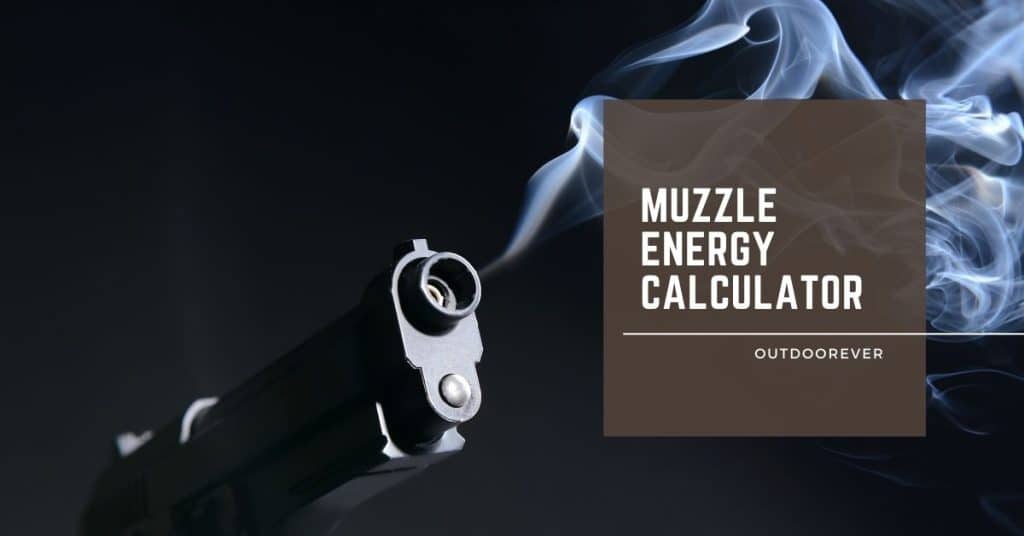Have you ever wondered how to calculate the muzzle energy and FPE of your firearm? Whether you’re a seasoned shooter or just getting started with firearms, understanding these metrics is crucial for gauging the performance of your ammunition and ensuring safe and effective shooting. In this guide, we’ll dive into the concepts of muzzle energy and FPE, how to calculate them using a muzzle energy calculator, and their significance in the world of firearms.
Muzzle Energy Calculator

What is Muzzle Energy
Muzzle energy refers to the kinetic energy generated by a bullet as it exits the barrel of a firearm. It’s a measure of the bullet’s potential to do work upon impact. In simple terms, muzzle energy indicates how “powerful” a bullet is. This energy is a critical factor in assessing the bullet’s effectiveness in various shooting scenarios.
Understanding FPE (Foot-Pounds of Energy) And Muzzle Energy Formula
The formula for calculating muzzle energy is as follows:
E = (M x V²) ÷ K
The well-known formula, muzzle energy = 0.5 * Mass * Velocity^2, elegantly captures the relationship between a projectile’s mass and velocity at the moment it exits the muzzle. However, you might be curious about the derivation of an alternative formula, E = (M x V²) ÷ K, and how it offers a different perspective on calculating muzzle energy. This variation takes into account the specific units used in the imperial system, particularly grains for weight and feet per second for velocity. The constant factor, K, is introduced to ensure that the final result is expressed in foot-pounds, which is a common unit for measuring energy in this context.
Where:
E represents the muzzle energy in foot-pounds.
M stands for the weight of the projectile, measured in grains.
V denotes the velocity of the projectile in feet per second.
K is a constant factor set at 450,435. (We will discuss below how we arrive at this value.)
To break down the formula further, let’s examine its individual components:
Projectile Weight (M):
The weight of the projectile, expressed in grains, is a critical element of the equation. The greater the projectile’s mass, the higher its potential muzzle energy. This weight includes the bullet itself and any additional components, such as the casing and propellant.
Projectile Velocity (V):
The velocity of the projectile refers to the speed at which it exits the muzzle. This value is measured in feet per second (fps) and is a decisive factor in determining muzzle energy. Higher velocities result in increased kinetic energy, enhancing the projectile’s impact potential.
Constant Factor (K):
The constant factor, denoted as K in the muzzle energy formula, is a crucial component that ensures the correct unit conversion for the final muzzle energy measurement in foot-pounds. This factor is derived through the following steps:
Conversion of Grains to Pounds:
The weight of the projectile, typically measured in grains, needs to be converted to pounds to maintain consistent units throughout the formula. There are approximately 7,000 grains in a pound.
Conversion of Feet to Pounds:
The unit of velocity, feet per second (fps), must be converted to pounds to match the converted weight of the projectile. This step involves using the acceleration due to gravity, which is approximately 32.1739 feet per second squared.
Multiplication of Conversion Factors:
To ensure that the final muzzle energy is expressed in foot-pounds, the conversions for both weight and velocity are combined. The formula for the constant factor, K, is:
K = 2 x 32.1739 x 7,000
Breaking down each term:
2: This term accounts for the factor of 2, ensuring proper alignment of the unit conversion.
32.1739: This term represents the acceleration due to gravity in feet per second squared. It’s used to convert velocity from feet per second to pounds.
7,000: This term converts grains to pounds.
By multiplying these three values, you obtain the constant factor, K. This constant is used in the muzzle energy formula to achieve the correct unit conversion and provide the muzzle energy measurement in foot pounds.
How To Use Our Muzzle Energy Calculator Or FPE Calculator:
The Muzzle Energy Calculator is a user-friendly tool that we designed to help firearm enthusiasts, hunters, and shooters in order to find the muzzle energy and FPE of their projectiles quickly and accurately. Whether you’re evaluating different ammunition options, fine-tuning your firearm for specific scenarios, or simply curious about the potential impact of your shots, this calculator provides valuable insights.
Here’s a step-by-step guide on how to use our Muzzle Energy Calculator effectively:
Step 1: Input Bullet Mass
The first field in the calculator requires you to input the bullet mass. Unlike traditional calculators that might expect the mass in grams, our calculator uses grains – a common unit for bullet mass in firearms. If you’re unfamiliar with grains, keep in mind that 1 pound is equivalent to 7,000 grains. Enter the bullet mass in grains into the provided field.
Step 2: Enter Projectile Velocity
The second field prompts you to enter the velocity of your projectile as it exits the muzzle of your firearm. This velocity should be given in feet per second (ft/s). If you’re uncertain about the exact velocity, you might find this information on the ammunition box, or you can use a chronograph or muzzle velocity calculator to measure it directly.
Step 3: Click “Calculate”
Once you’ve entered both the bullet mass in grains and the projectile velocity in ft/s, click the “Calculate Muzzle Energy” button. The calculator will then swiftly process the provided information and perform the necessary calculations.
Interpreting the results from the “Calculate” button provides you with the muzzle energy in foot-pounds, representing the kinetic energy of the projectile as it leaves your firearm. This data informs your decisions about ammunition, shooting scenarios, and more. You can also use this value to analyze and compare different loads, assess your firearm’s suitability for various purposes, and determine your chosen ammunition’s stopping power.
While muzzle energy is a vital metric in evaluating ammunition and firearm performance, it’s just one of many factors. As you become more familiar with the Muzzle Energy Calculator, you’ll make more informed decisions for your shooting needs, whether for fine-tuning your firearm setup, optimizing for hunting, or participating in shooting competitions.
Process of Calculating Muzzle Energy:
Cracking the code behind the muzzle energy of a projectile involves a straightforward formula:
Muzzle Energy (ft-lbs) = {bullet weight in grain × (velocity in fps)^2} / k
To bring this formula to life, let’s work through an illustrative example:
Imagine, Emily selects a high-performance bullet that weighs 0.02 pounds (approximately 0.32 ounces or 140 grains). With unwavering focus, she fires the bullet from her firearm at a remarkable velocity of 1200 feet per second. We also know the value of k which is 450395
Applying these values to the formula:
Muzzle Energy = 140 * (1200 ft/s)^2/ 450395
Solving for the squared velocity:
Muzzle Energy = 140 * 1440000 / 450395
Calculating the muzzle energy:
Muzzle Energy = 447.60 ft-lbs
Here, the intrinsic relationship between the bullet’s mass and its velocity becomes evident. With an increase in either of these variables, the resulting muzzle energy surges, potentially leading to more impactful outcomes upon impact.
In this particular case, Emily’s chosen ammunition generates a muzzle energy of 447.60 foot pounds. This measurement holds crucial insights into the ammunition’s capacity to deliver force and create a substantial impact when it strikes a target.
So, whether it’s Emily’s precise marksmanship or the science of muzzle energy, this formula serves as a key to unlocking the latent power within projectiles.
In this equation, the bullet mass assumes dimensions in pounds, while velocity is quantified in feet per second. The intrinsic connection between projectile weight and its velocity springs to life here. As either variable ascends, the resultant muzzle energy escalates, potentially yielding more profound consequences upon impact.

About The Author:
Lake Streeter, A Gun enthusiast, and loves to hunt in the middle of the wood. Always check the latest hunting gears out in the market and try to share his honest opinion with the audience in Hunting Nook.
